<> Parantica aglea (Stoll,[1782]) <>
the Glassy Tiger ผีเสื้อลายเสือขีดยาว
Click on any photo to see all photos full size in Lightbox
Additions and corrections to the information provided on this page is always welcome. Please use the Contact form.

Photo taken at Doi Suthep-Pui National Park, Chiang Mai, Thailand. 460m a.s.l.

Parantica aglea is the most common and widespread of the Parantica genus and is found throughout most of the region thanks to its acceptance of a wide variety of larval hosts from the Apocynaceae family of plants. It is a fairly large butterfly and the sexes are quite similar in appearance. There is some variance in the wing colours being black or dark brown and having light blue or white markings. This variation tends to be between different populations rather than being regional. They have a fairly strong but leisurely flight.
Like some other Danainae species they obtain pyrrolizidine alkaloids from fluids oozing from certain plant stems and seedpods and this makes them unpalatable to predators such as birds. Both sexes are seen regularly mud puddling and visiting flowers for nectar. Thanks to a relatively short lifecycle the species is multivoltine with many broods per annum.
Synonyms and previously used names: Papilio aglea, Danais aglea, Danaida aglea, Danaus aglea
Taxonomy: Animalia - Arthropoda - Insecta - Lepidoptera - Nymphalidae - Danainae - Parantica - aglea
Regional subspecies: P.a.maghaba (Taiwan), P.a.melanoides (Nepal, Bhutan, India, Myanmar, Thailand, Laos, Cambodia, Vietnam, China, W.Malaysia)
Regional Distribution: India, Nepal, Bhutan, Bangladesh, Myanmar, Thailand, Laos, Cambodia, Vietnam, China, Taiwan, Malaysia, Indonesia
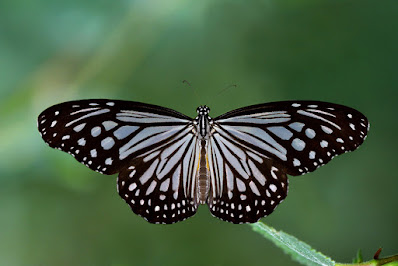 |
| Doi Suthep-Pui National Park, Chiang Mai, Thailand 460m a.s.l. |
Habitat: Parantica aglea prefers open but sheltered environments which include evergreen, deciduous, and bamboo forest, grassland, and scrubland. They are also often seen around flowers in urban parks and gardens. Although usually found at lower elevations they have been recorded at up to 2500m a.s.l.
Flight time: all year depending on location Wingspan: 70-85mm
Life History: egg 5 days instar 1 3 days instar 2 2-3 days instar 3 2-3 days instar 4 3-4 days instar 5 3-4 days pupa 8-9 days Total egg to adult 26-31 days. All times are approximate.
Larval Hosts: Asclepias curassavica, Calotropis gigantea, Ceropegia bulbosa, Ceropegia candelabrum, Ceropegia evansii, Ceropegia hirsuta, Ceropegia lawii, Ceropegia media, Ceropegia vincifolia, Cryptolepis buchanani, Cynanchum lanhsuense, Cynanchum ovalifolium, Heterostemma brownii, Heterostemma tanjorense, Parsonsia alboflavescens, Vincetoxicum bracteatum, Vincetoxicum carnosum, Vincetoxicum dalzellii, Vincetoxicum flexuosum, Vincetoxicum hirsutum, Vincetoxicum indicum, Vincetoxicum iphisia (Apocynaceae). Actual host plant used depends upon location and availabilty of plant species.
Adult Food Sources: Nectar - Cordia cylindrostachya, Heliotropium indicum, Trichodesma indicum, Trichodesma zeylanica (Boraginaceae), Crotalaria juncea, Crotalaria mucronata, Crotalaria pallida, Crotalaria retusa (Fabaceae), Lantana camara, Stachytarpheta jamaicensis (Verbenaceae), Ageratum conyzoides, Bidens pilosa, Chromolaena odorata, Crassocephalum rubens, Zinnia elegans (Asteraceae), Zanthoxylum avicennae (Rutaceae), Rhamnus wightii (Rhamnaceae), Pseuderanthemum reticulatum (Acanthaceae), Vitex negundo (Lamiaceae). Other - mud puddling, plant stem sap.
 |
| Chiang Dao Nature Sanctuary, Chiang Mai, Thailand |
 |
| Chiang Dao Nature Sanctuary, Chiang Rai, Thailand |
 |
| Crotalaria juncea, a nectar source |
 |
| egg of Parantica aglea |
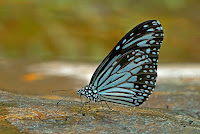 |
| Doi Suthep-Pui National Park, Chiang Mai, Thailand |
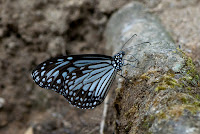 |
| Lamnamkok National Park, Chiang Rai, Thailand |
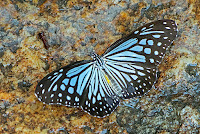 |
| Doi Suthep-Pui National Park, Chiang Mai, Thailand |
 |
| Heliotropium indicum, another nectar source |
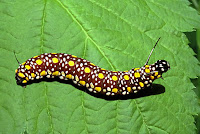 |
| late instar larva |
 |
| Doi Suthep-Pui National Park, Chiang Mai, Thailand |
 |
| Doi Suthep-Pui National Park, Chiang Mai, Thailand |
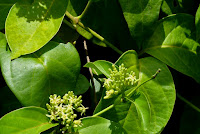 |
| Parsonsia alboflavescens, a larval host |
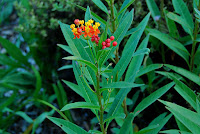 |
| Asclepias curassavica, another larval host |
Links to other pages in this series for species in the same subfamily
